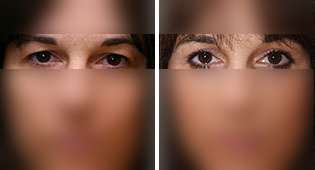Blepharoplasty (eyelid surgery)
Remove droopy eyelids to give you bright, open eyes that takes years off your appearance.
With increasing age the skin of the upper eyelid may droop down and partially or completely obscure the natural upper lid fold which typically lies about 10mm from the lid margin. There may also be an excessive bulging of the lid due to herniation of orbital fat. In the lower lid similar changes in the periorbital skin and fat may also cause unsightly sagging and bulging of the eyelid region.
Droopy eyelids can make you look older and can also impair vision. Blepharoplasty corrects these problems and also removes puffiness and bags under the eyes that make you look worn and tired. Fat is often removed along with excess skin and muscle from the upper and lower eyelids. This procedure cannot alter dark circles, fine lines and wrinkles around the eyes, nor can it change sagging eyebrows. While it can add an upper eyelid crease to Asian eyes, it will not erase evidence of your ethnic or racial heritage.
If you are wondering how blepharoplasty can change the way you look, you need to know how eyelid surgery is performed and what you can expect from this procedure. Successful facial plastic surgery is a result of good rapport between patient and surgeon. Trust, based on realistic expectations and exacting medical expertise, develops in the consulting stages before surgery. Your surgeon can answer specific questions about your specific needs. .As with all facial plastic surgery, good health and realistic expectations are prerequisites.
During the pre-surgical consultation, you will be examined or asked to answer queries concerning vision, tear production, use of lenses, and your desires for surgery. Your surgeon will explain what you can expect from blepharoplasty and take a complete medical history. Factors to be weighed include age, skin type, ethnic background, and degree of visual obstruction. After a mutual decision is made by both you and your surgeon, the technique indicated for your individual surgery will be discussed. The type of anesthesia, the surgical facility, any supportive surgery, and the risks and costs inherent in the procedure will be outlined.
Understanding the surgery
In upper eyelid surgery, the surgeon first marks the individual lines and creases of the lids in order to keep the scars as invisible as possible along these natural folds. The incision is made, and excess fat, muscle, and loose skin are removed. Fine sutures are used to close the incisions, thereby minimizing the visibility of any scar.
In lower eyelid surgery, the surgeon makes the incision in an inconspicuous site along the lash line and smile creases of the lower lid. Excess fat, muscle, and skin are then trimmed away before the incision is closed with fine sutures. Eyelid puffiness caused primarily by excess fat may be corrected by a transconjunctival blepharoplasty. The incision in this case is made inside the lower eyelid, and excess fatty material is removed. When sutures are used to close this kind of incision, they are invisible to the eye. They are also self-dissolving and leave no visible scar. Under normal conditions, blepharoplasty can take from one to two hours.
What to expect after the surgery
Immediately after the surgery has been completed, your surgeon may apply tiny sterile bandages. This is not done for transconjunctival blepharoplasty. It is not crucial that the eyes be covered. However, an ointment to prevent dryness of the eye area may be used. A certain degree of swelling and bruising is normal. Cold compresses, as well as head elevation when lying down, will enhance healing and relieve discomfort. Your surgeon will prescribe medication for discomfort.
For a week and a half following blepharoplasty, you will clean the eye area (the eyes may feel sticky, dry, and itchy). Eyedrops may be recommended. Your surgeon will also list activities and environments to avoid in the weeks immediately following surgery. Permanent stitches will be removed in five to seven days after surgery. Self-absorbing stitches will dissolve on their own.
Insurance does not generally cover surgery that is done purely for cosmetic reasons. Surgery to correct or improve vision or surgery for eye deformity or injury may be reimbursable in whole or in part.
